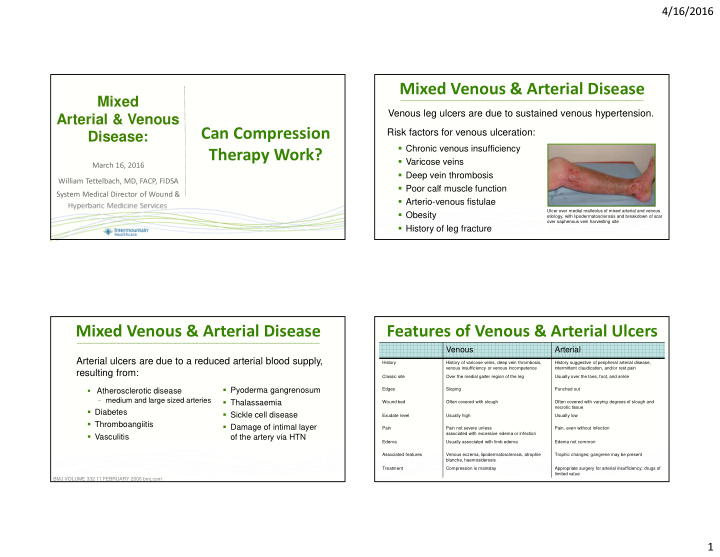



4/16/2016 Mixed Venous & Arterial Disease Mixed ___________________________________________________________ Arterial & Venous Venous leg ulcers are due to sustained venous hypertension. Disease: Risk factors for venous ulceration: Can Compression � Chronic venous insufficiency Therapy Work? � Varicose veins March 16, 2016 � Deep vein thrombosis William Tettelbach, MD, FACP, FIDSA � Poor calf muscle function System Medical Director of Wound & � Arterio-venous fistulae Hyperbaric Medicine Services Ulcer over medial malleolus of mixed arterial and venous � Obesity etiology, with lipodermatosclerosis and breakdown of scar over saphenous vein harvesting site � History of leg fracture Mixed Venous & Arterial Disease Features of Venous & Arterial Ulcers ___________________________________________________________ Venous Arterial Arterial ulcers are due to a reduced arterial blood supply, History History of varicose veins, deep vein thrombosis, History suggestive of peripheral arterial disease, venous insufficiency or venous incompetence intermittent claudication, and/or rest pain resulting from: Classic site Over the medial gaiter region of the leg Usually over the toes, foot, and ankle � Pyoderma gangrenosum Edges Sloping Punched out � Atherosclerotic disease - medium and large sized arteries � Thalassaemia Wound bed Often covered with slough Often covered with varying degrees of slough and necrotic tissue � Diabetes � Sickle cell disease Exudate level Usually high Usually low � Thromboangiitis � Damage of intimal layer Pain Pain not severe unless Pain, even without infection associated with excessive edema or infection � Vasculitis of the artery via HTN Edema Usually associated with limb edema Edema not common Associated features Venous eczema, lipodermatosclerosis, atrophie Trophic changes; gangrene may be present blanche, haemosiderosis Treatment Compression is mainstay Appropriate surgery for arterial insufficiency; drugs of limited value BMJ VOLUME 332 11 FEBRUARY 2006 bmj.com 1
4/16/2016 Compression Therapy Arterial Brachial Index ___________________________________________________________ ___________________________________________________________ Compression classes of compression hosiery used in several countries. ABI Perfusion Status (Values in mmHg, 1 mmHg = 1,333 hPa) > 1.3 Elevated, incompressible vessels USA United Kingdom France Germany 1.0 - 1.3 Normal 15 - 20 (moderate) 14 - 17 (light) 10 - 15 18 - 21 (light) ≤ 0.9 Lower extremity arterial disease suspected 20 - 30 (firm) 18 - 24 (medium) 15 - 20 23 - 32 (medium) ≤ 0.6 to 0.8 Borderline 30 - 40 (extra firm) 25 - 35 (strong) 20 - 36 34 - 46 (strong) ≤ 0.5 Severe ischemia 40+ > 36 > 49 (very strong) < 0.4 or a toe pressure Critical Ischemia, Limb Threatening < 30 mmHg The values indicate the compression exerted by the hosiery at a hypothetical cylindrical ankle. Eur J Vasc Endovasc Surg Vol 35, April 2008 Arterial Brachial Index Compression Therapy ___________________________________________________________ ___________________________________________________________ CONTRAINDICATIONS for ABI: 1 Indications for a coban 2 layer compression system: � Excruciating pain in lower legs/feet. � 30 - 40 mmHg wrap (resting pressure) � Deep vein thrombosis (DVT), which could lead to - Used on patients with an ABI equal to 0.8 or greater. dislodgement of the thrombosis, where referral would be indicated for a duplex ultrasound test. � 20 - 30 mmHg wrap (resting pressure) � Severe pain associated with lower extremity wound(s). - Used on patients with an ABI equal to 0.5 or greater. Junger M, Haase H, Ladwig A, Schwenke L, Bichel J, Schuren J. Compression therapy in patients with peripheral arterial occlusive disease: A 1. Grenon SM, Gagnon J, Hslang J. Ankle-brachial index for assessment of peripheral arterial disease. N Engl J Med . 2009;361:e40. prospective clinical study with the 3M Coban 2 Layer Lite Compression System for ABPI > 0.5. 2010. 2
4/16/2016 Mixed Venous & Arterial Disease Compression Therapy ___________________________________________________________ ___________________________________________________________ In patients with mixed ulceration, an ankle-brachial 1 Absolute CONTRAINDICATIONS for application of compression: pressure index >0.5 and an absolute ankle pressure of >60 mmHg, inelastic compression of up to 40 mmHg does not � A florid infection (e.g., phlegmon, abscess) impede arterial perfusion but may lead to a normalization of � Advanced peripheral arterial occlusive disease the highly reduced venous pumping function. - ABI is < 0.5 mmHg or a toe pressure < 30 mmHg Such bandages are therefore recommended in � Acute decompensated heart failure combination with walking exercises as the basic � Phlegmasia coerulea dolens conservative management for patients with mixed leg - extensive thrombotic occlusion of the major and the collateral veins ulcers. Mosti G, Iabicella ML, Partsch H. Compression therapy in mixed ulcers increases venous output and arterial perfusion. Vasc Surg 2011;55:122–8. 1. EWMA JOURNAL 2013 VOL 13 NO 2 Mixed Venous & Arterial Disease ___________________________________________________________ Thank you for your time Once ulcer has healed, goal is to prevent recurrence: � Wearing compression stockings Questions? � Skin care � Leg elevation � Calf exercises � Optimizing diet 3
Recommend
More recommend